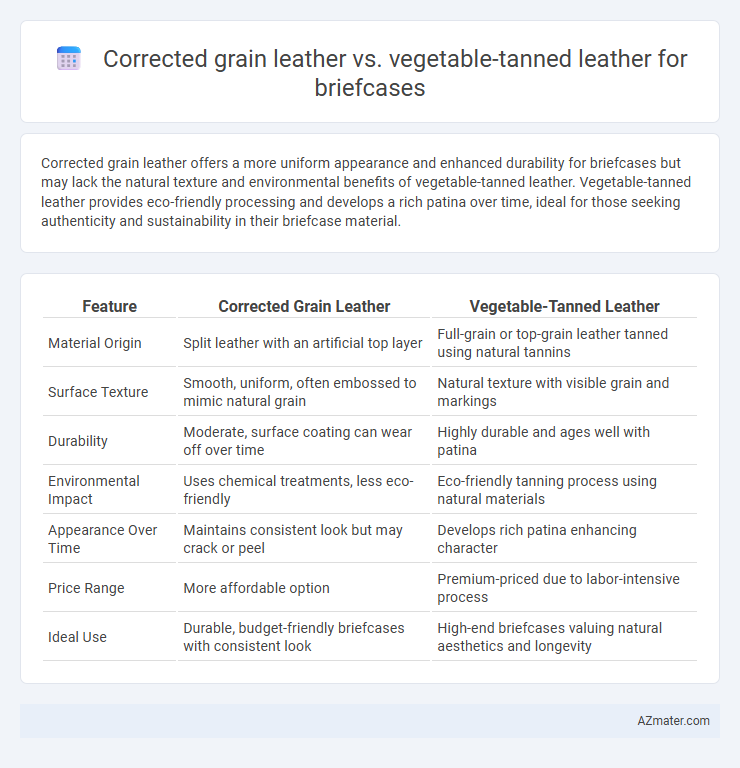Corrected grain leather offers a more uniform appearance and enhanced durability for briefcases but may lack the natural texture and environmental benefits of vegetable-tanned leather. Vegetable-tanned leather provides eco-friendly processing and develops a rich patina over time, ideal for those seeking authenticity and sustainability in their briefcase material.
Table of Comparison
| Feature | Corrected Grain Leather | Vegetable-Tanned Leather |
|---|---|---|
| Material Origin | Split leather with an artificial top layer | Full-grain or top-grain leather tanned using natural tannins |
| Surface Texture | Smooth, uniform, often embossed to mimic natural grain | Natural texture with visible grain and markings |
| Durability | Moderate, surface coating can wear off over time | Highly durable and ages well with patina |
| Environmental Impact | Uses chemical treatments, less eco-friendly | Eco-friendly tanning process using natural materials |
| Appearance Over Time | Maintains consistent look but may crack or peel | Develops rich patina enhancing character |
| Price Range | More affordable option | Premium-priced due to labor-intensive process |
| Ideal Use | Durable, budget-friendly briefcases with consistent look | High-end briefcases valuing natural aesthetics and longevity |
Understanding Corrected Grain Leather
Corrected grain leather is made by sanding and buffing the hide's surface to remove imperfections, then applying a surface coating to create a uniform texture ideal for briefcases. This leather type offers enhanced durability and stain resistance, making it practical for everyday use while maintaining a polished appearance. Compared to vegetable-tanned leather, corrected grain leather generally provides a smoother finish and requires less maintenance but lacks the natural aging characteristics valued in vegetable-tanned products.
What is Vegetable-Tanned Leather?
Vegetable-tanned leather is crafted using natural tannins extracted from tree bark and plant materials, resulting in a durable and environmentally friendly product ideal for briefcases. This type of leather develops a rich patina over time, enhancing its aesthetic appeal and longevity. In contrast to corrected grain leather, which undergoes extensive surface treatment, vegetable-tanned leather maintains a more natural texture and breathability, making it a preferred choice for high-quality, classic briefcases.
Durability: Corrected Grain vs Vegetable-Tanned Leather
Corrected grain leather features a surface that has been buffed and coated to cover imperfections, offering enhanced resistance to water and stains but potentially sacrificing breathability and natural aging. Vegetable-tanned leather, crafted using organic tannins, develops a rich patina over time, improving its durability and character while maintaining breathability and strength. For briefcases, corrected grain leather provides a more uniform and protective exterior, whereas vegetable-tanned leather offers long-term resilience and unique aging with proper care.
Appearance and Texture Comparison
Corrected grain leather for briefcases features a smooth, uniform surface achieved through sanding and pigment application, offering a consistent appearance but less natural texture. Vegetable-tanned leather presents a rich, natural patina with visible grain and unique markings, creating a more authentic and tactile experience. The texture of vegetable-tanned leather is typically firmer and develops character over time, while corrected grain leather remains more processed and durable but less distinctive.
Maintenance and Care Requirements
Corrected grain leather briefcases require regular cleaning and conditioning to maintain flexibility and prevent surface cracking due to their buffed and coated finish. Vegetable-tanned leather demands minimal but consistent care, including light cleaning and conditioning with natural oils to enhance patina development and durability over time. Both types benefit from avoiding prolonged exposure to moisture and direct sunlight to preserve their structural integrity and appearance.
Environmental Impact and Sustainability
Vegetable-tanned leather involves natural tannins from plant sources, making it biodegradable and less harmful to ecosystems compared to corrected grain leather, which undergoes extensive chemical treatments and synthetic dyeing that increase its environmental footprint. Corrected grain leather's correction process often involves sanding and applying pigments to conceal imperfections, leading to higher emissions and chemical waste. Choosing vegetable-tanned leather for briefcases supports sustainable practices by reducing pollutant exposure and encouraging eco-friendly leather production.
Aging and Patina Development
Corrected grain leather undergoes surface buffing and artificial embossing, resulting in a more uniform appearance but limited natural aging and patina development compared to vegetable-tanned leather. Vegetable-tanned leather, crafted using natural tannins from tree bark, develops a unique, rich patina over time, enhancing its character and aesthetic appeal with use. For briefcases, vegetable-tanned leather offers a superior aging process that showcases individual wear patterns, while corrected grain leather maintains a consistent look but lacks distinctive aging traits.
Cost Differences: Which is More Expensive?
Vegetable-tanned leather briefcases generally cost more than corrected grain leather due to the natural tanning process requiring higher-quality raw materials and longer production times. Corrected grain leather undergoes extensive surface treatments and embossing, making it less expensive to produce and more affordable for consumers. The premium durability and eco-friendly tanning of vegetable-tanned leather justify its higher price point in luxury briefcase markets.
Suitability for Briefcases
Corrected grain leather offers durability and a uniform appearance, making it suitable for briefcases that require resistance to wear and consistent aesthetics. Vegetable-tanned leather provides a natural finish and develops a unique patina over time, enhancing the briefcase's character and appeal for professional use. Both leathers balance functionality and style, but vegetable-tanned leather is preferred for premium, handcrafted briefcases due to its eco-friendly tanning process and personalized aging.
Final Verdict: Choosing the Right Leather for Your Briefcase
Corrected grain leather offers enhanced durability and a uniform appearance, making it ideal for briefcases that require resistance to scratches and stains. Vegetable-tanned leather provides a unique patina with time, appealing to those who value natural aging and eco-friendly processes in their accessories. Choosing the right leather depends on prioritizing longevity and maintenance ease with corrected grain, or embracing character development and sustainability with vegetable-tanned leather for your briefcase.

Infographic: Corrected grain leather vs Vegetable-tanned leather for Briefcase
 azmater.com
azmater.com